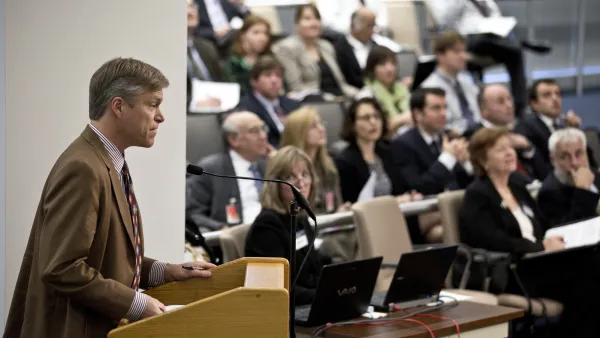For most planning programs in the U.S. this is the end of the semester. Having read literally hundreds of papers over the past few months I have reflected on the lessons of better papers for writing in planning.
For most planning programs in the U.S. this is the end of the semester. Having read literally hundreds of papers over the past few months I have reflected on the lessons of better papers for writing in planning.
- Find the right level of ambition. Papers or reports that are too ambitious risk seeming unfocused and shallow. On the other hand papers (or planning reports) lacking ambition-perhaps describing a place through one fairly standard lens-may just not say enough of interest to do really well.
- Make an argument that someone else will care about. A simple description of a standard phenomenon can demonstrate that you have some knowledge of a topic but a better paper convinces the reader that this matters to them or to the world.
- Make an argument that hangs together. Try diagramming your argument-your claim, evidence, qualifications, and so on. If you can't diagram it, you may not have much of an argument. My favorite book on writing papers-Booth et al.'s (2008) the Craft of Research-has great tips.
- Demonstrate that you understand your sources. As a planner you are typically writing for experts-other professionals, council members who know their constituencies, residents who know their neighborhoods. Using sources selectively to support opinions you merely mean to illustrate, rather than argue for, will undermine your credibility. Failing to show an understanding of which studies and datasets can support which kinds of claims will get you in similar hot water. Show you know when an oral history is great evidence and when you need a cost-benefit study.
- Use multiple data sources where possible. Making a coherent argument from statistics, observations, maps, interviews, and historical information is tricky but is likely to be a better argument than one based on a single source. Incidentally some people find certain data sources more convincing than others and you are more likely to hit on one of these sources if you use several.
- Get key technical terms right. Don't mix up the Athens Charter and the Charter of the New Urbanism-there are commonalities but experts in urban design know the difference.
This is my April blog quite late.

Analysis: Cybertruck Fatality Rate Far Exceeds That of Ford Pinto
The Tesla Cybertruck was recalled seven times last year.

National Parks Layoffs Will Cause Communities to Lose Billions
Thousands of essential park workers were laid off this week, just before the busy spring break season.

Retro-silient?: America’s First “Eco-burb,” The Woodlands Turns 50
A master-planned community north of Houston offers lessons on green infrastructure and resilient design, but falls short of its founder’s lofty affordability and walkability goals.

Test News Post 1
This is a summary

Analysis: Cybertruck Fatality Rate Far Exceeds That of Ford Pinto
The Tesla Cybertruck was recalled seven times last year.

Test News Headline 46
Test for the image on the front page.
Urban Design for Planners 1: Software Tools
This six-course series explores essential urban design concepts using open source software and equips planners with the tools they need to participate fully in the urban design process.
Planning for Universal Design
Learn the tools for implementing Universal Design in planning regulations.
EMC Planning Group, Inc.
Planetizen
Planetizen
Mpact (formerly Rail~Volution)
Great Falls Development Authority, Inc.
HUDs Office of Policy Development and Research
NYU Wagner Graduate School of Public Service





























